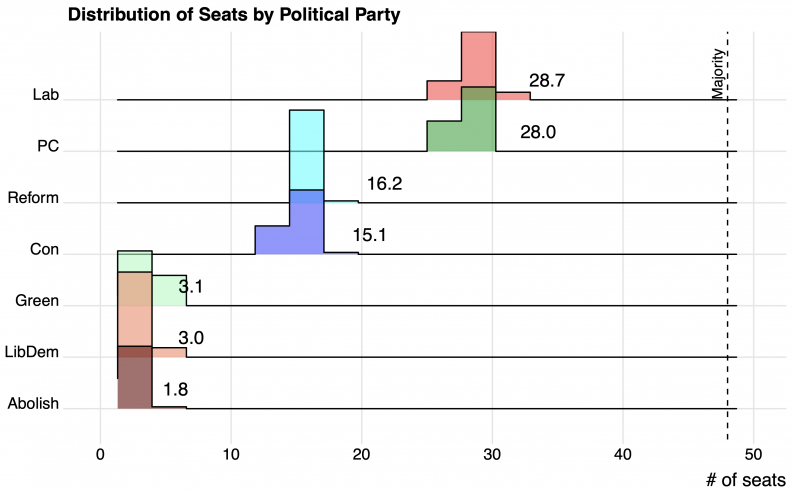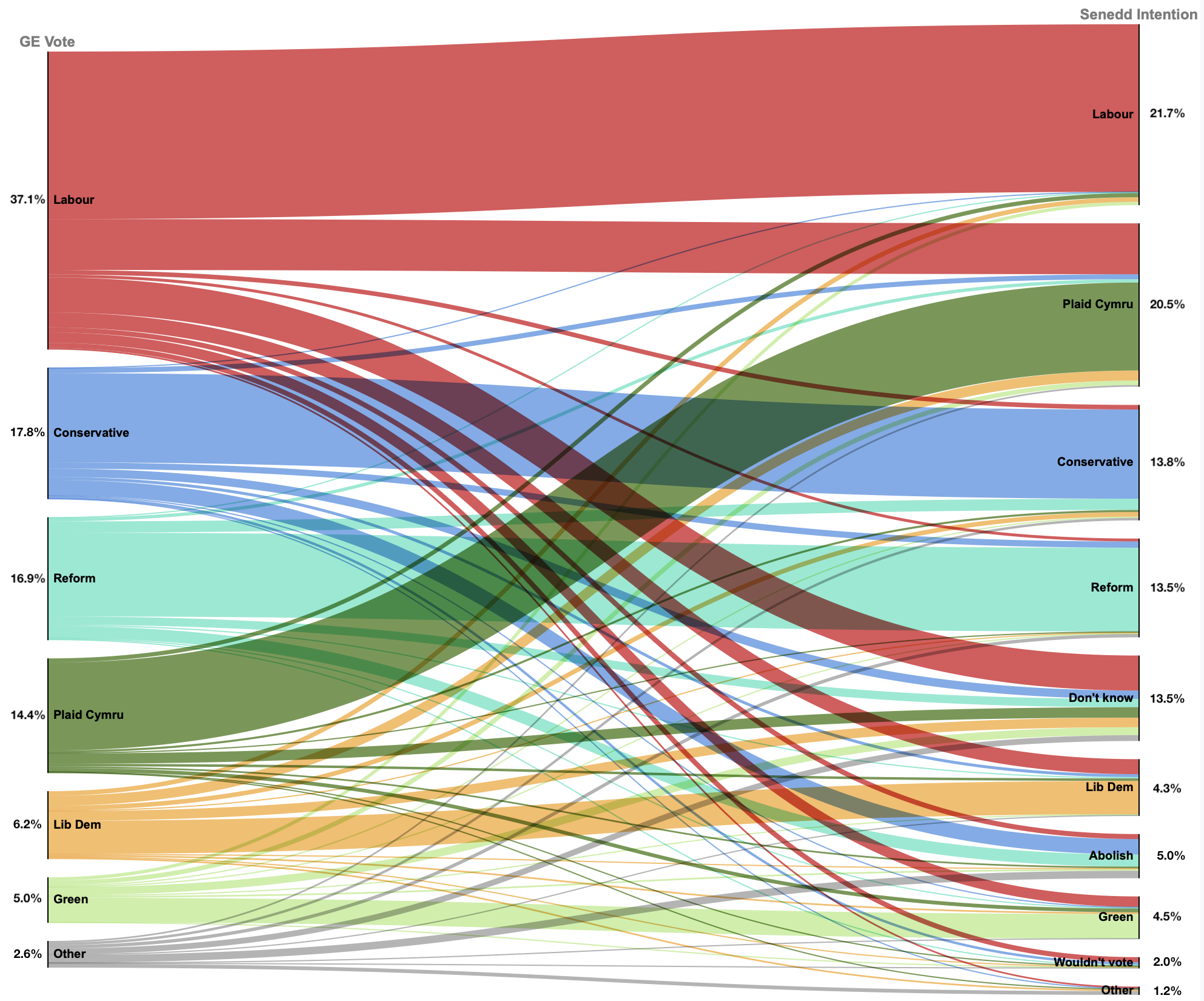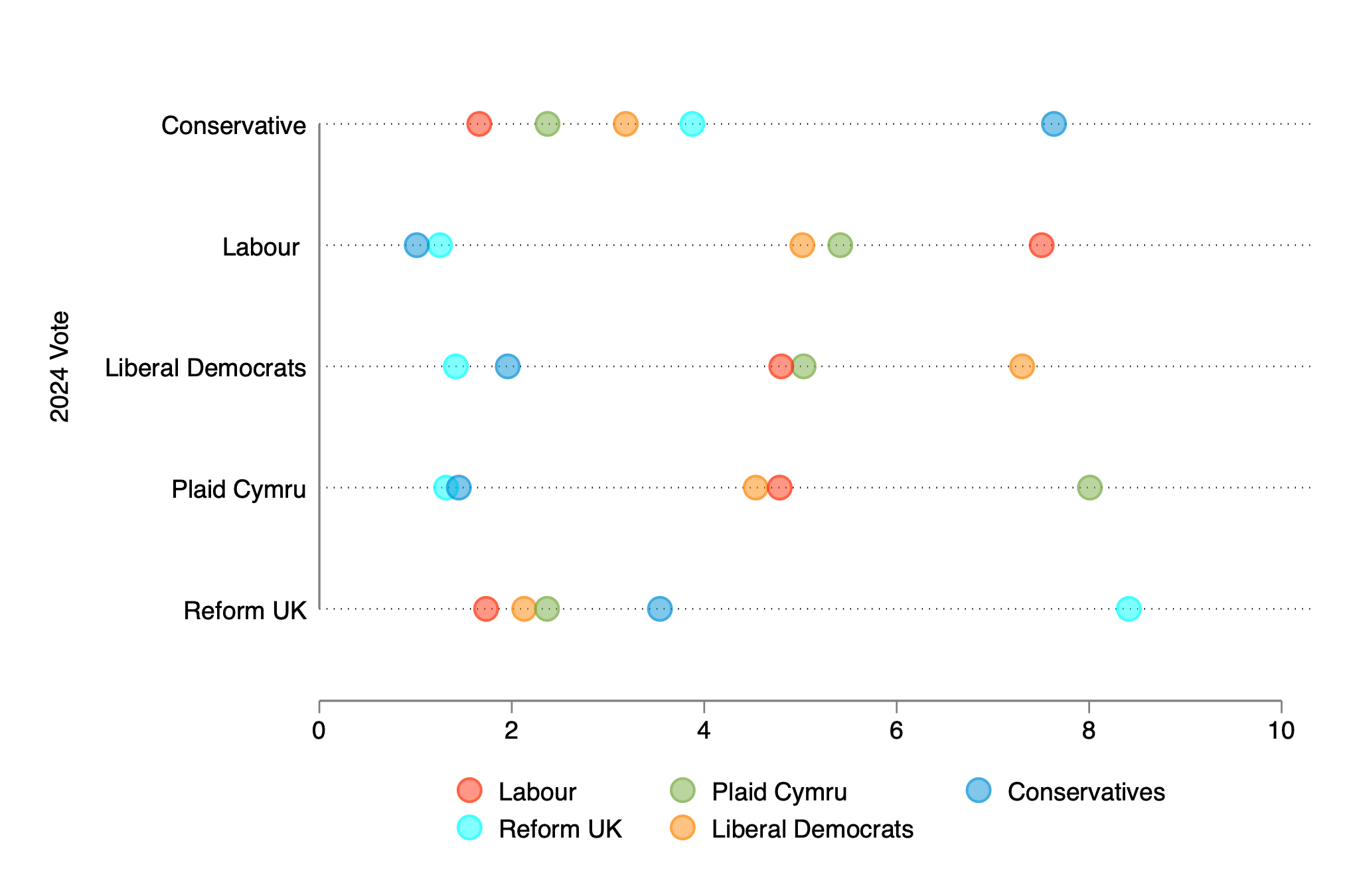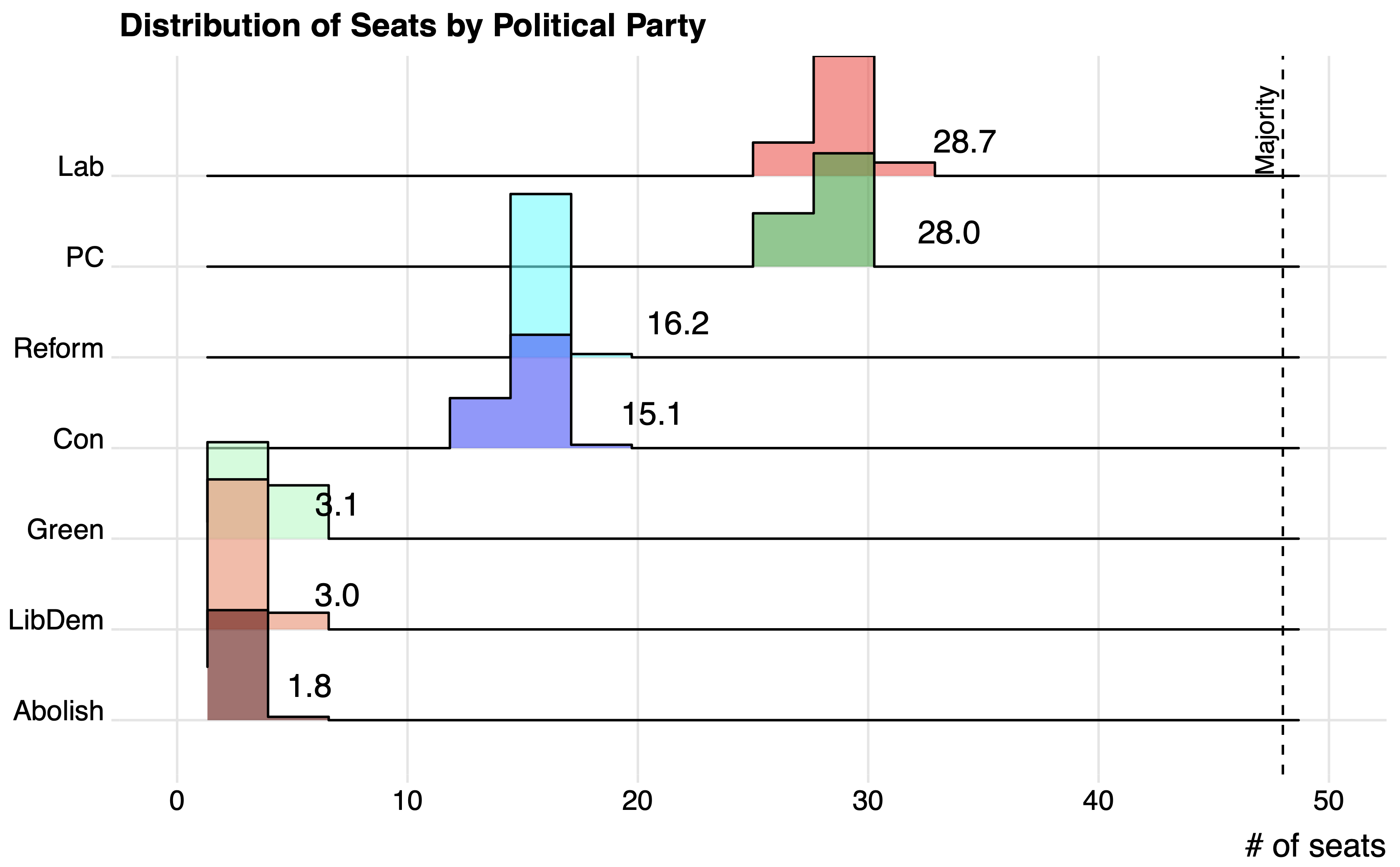The Welsh Electoral Pendulum: The Multilevel Voter and Switching between Westminster and Senedd Elections
28 July 2024
The 2026 Senedd election will mark a new era of devolution in Wales, with an expanded Senedd and a new electoral system unlocking new dynamics of party competition. In this blog post, I lay out the current state of opinion in Wales using data from the 2024 Welsh Election Study and provide seat projections for a Senedd election under the new electoral system.
Multilevel Voting in Wales
In Welsh elections, we consistently observe a phenomenon known as multilevel voting. This isn’t the natural ‘churn’ between elections where voters reassess parties and adjust their choices accordingly. Instead, multilevel voting is a deliberate, systematic practice where voters support different parties at various levels of government. It’s a predictable pattern, distinct from typical voting fluctuations. During the most recent election campaign, opinion polls revealed an increase in this behaviour. The number of respondents indicating their intent to vote for different parties at different governmental levels reached some of the highest figures we’ve ever recorded.
The Welsh Election Study’s post-election survey (collected 5-18 July, N=2,565) asked respondents about their voting choices in two scenarios: their actual vote in the 4 July General Election and their hypothetical vote in a Senedd election. Figure 1 visualises this data, illustrating the flow of voters between these two electoral contexts. The diagram excludes non-voters, focusing instead on how participants who cast ballots on 4 July would potentially shift their support in a Senedd election. This visualization offers a clear picture of multilevel voting patterns, showcasing how voters’ party preferences might change across different levels of government.

The Figure reveals a stark contrast between voting intentions at different governmental levels. Labour’s commanding 20-point lead over Plaid Cymru in Westminster elections shrinks dramatically to a mere one-point advantage when considering Senedd voting intentions. This shift is primarily driven by a direct transfer of voters from Labour to Plaid Cymru for Senedd elections, although the high number of undecided voters (“DKs”) is also noteworthy. This pattern has been a consistent feature throughout the devolution era, but our survey data indicates that the magnitude of this voter transfer has been gradually increasing since 2011. Other significant, albeit less pronounced, shifts include Conservative voters gravitating towards the Abolish the Assembly Party. This trend, observed in the past two Senedd elections, reflects an increasingly devosceptic stance among many Conservative supporters.
The substantial voter migration between Labour and Plaid Cymru can be attributed to a simple factor: mutual appreciation among their supporters. A standard election study question asks respondents to rate parties on a 0-10 scale, with 0 indicating strong dislike and 10 signifying strong approval. The Figure below illustrates the average ratings for each party, categorized by 2024 voting patterns. Predictably, voters give the highest scores to their chosen party. However, the most intriguing aspect lies in the ratings given to parties other than the one voted for. Notably, the smallest gap exists between Labour voters’ assessments of Labour and Plaid Cymru, explaining the ease of voter transfer between these parties. In contrast, the Conservatives face a worrying trend: Reform voters show little affinity for the Conservative party, suggesting a significant challenge in reclaiming these voters in future elections.

Finally, the phenomenon of multilevel voting extends beyond mere ballot choices, influencing even traditionally ‘fixed’ aspects of political behaviour such as party identity. This psychological attachment, typically formed during adolescence or early adulthood, is usually considered stable. However, our study reveals a surprising fluidity in party loyalties across different levels of government. Even among committed partisans (only 50% of the sample), we observed a notable divergence in party support between governmental levels. A striking example is the approximately 16% of self-identified Labour Party supporters who simultaneously considered themselves Plaid Cymru supporters in the Welsh arena. This Labour-to-Plaid Cymru transfer of partisan loyalty was the most significant observed between any two parties, underscoring the complexity of political affiliations in the Welsh context.
What does this mean for a future Senedd election?
Excluding non-voters and undecided respondents**, the data yields the following Senedd vote intention: Labour 25%, Plaid Cymru 24%, Conservatives 16%, Reform UK 16%, Abolish 7%, Green Party 6%, Liberal Democrats 6%, Other 1%. These figures form the basis for our seat projections.
The new electoral system requires pairing the 32 current Westminster constituencies into 16 larger ones. With over 2,000 possible twinning arrangements (assuming adjacent constituencies paired once), making assumptions about ‘logical’ pairings could significantly skew results. To minimise this bias, I randomly selected 1,000 possible arrangements and modelled seat distributions for a hypothetical Senedd election. Figure 3 displays these simulation outcomes. The height of each bar represents the frequency of projected seat numbers, and I’ve noted the mean number of seats won by each party.

Multiple points are worth addressing here. The first, is the incredibly close race for the largest party, with Labour and Plaid Cymru neck and neck. One byproduct of this tight race is that no single party is close to winning a majority of seats in the new expanded Senedd, requiring some sort of agreement between several parties. Just as there is a tight race at the top, the competition for the third largest party is also incredibly close. As things stand however, there is little prospect of a combined right-of-centre government (even when including Abolish in this calculation). The Greens, Liberal Democrats, and Abolish the Welsh Assembly (sic) Party are projected to win far fewer seats, but given the lack of clear government formation combinations could end up wielding substantial amounts of power, acting as potential Kingmakers.
Caveats
- There are two years until the next scheduled Senedd election and things can change substantially in that time. This is just a snapshot of things as they currently stand.
- People have not voted under the new electoral system, and many won’t even be aware there has been a change to the electoral system. We know that people vote differently under different electoral systems so we might not be picking these changes up.
- My model assumes a uniform national swing using estimates I’ve produced of what the 2021 election would have looked like using the new 32 Welsh Westminster constituencies. To do this I use data from the 2021 Welsh Election Study combined with demographic information for each constituency. Again, this required several assumptions on my part which might be flawed (I’ll publish these in full over the next few weeks).
- There are opinion polls by other firms, notably Redfield and Wilton, that have significantly different figures to the Welsh Election Study’s Senedd vote intention figures. If we were to use these numbers instead, the picture would look far better for Labour and the Conservatives and worse for Plaid Cymru and Reform (though I think it’s fair to note they overestimated Labour vote share in the General election by roughly 9 points)
The Data
The Welsh Election Study (WES) is a detailed independent study of politics and elections in Wales, funded by the Economic and Research Council. In the most recent UK General election, the study conducted surveys in two waves on a representative study of the Welsh voting age public with a sample size of approximately 2,500 people. Respondents were interviewed once before the election, and one afterwards. All previous election study data are publicly available here, with full 2024 dataset published at the end of August.
- December 2025
- November 2025
- October 2025
- September 2025
- June 2025
- May 2025
- March 2025
- February 2025
- December 2024
- October 2024
- September 2024
- July 2024
- June 2024
- December 2023
- November 2023
- August 2023
- February 2023
- December 2022
- November 2022
- September 2022
- July 2022
- April 2022
- March 2022
- January 2022
- October 2021
- July 2021
- May 2021
- March 2021
- January 2021
- November 2020
- October 2020
- August 2020
- July 2020
- June 2020
- May 2020
- April 2020
- March 2020
- October 2019
- September 2019
- June 2019
- April 2019
- March 2019
- February 2019
- December 2018
- October 2018
- July 2018
- June 2018
- April 2018
- December 2017
- October 2017
- July 2017
- June 2017
- May 2017
- April 2017
- March 2017
- February 2017
- January 2017
- December 2016
- November 2016
- October 2016
- September 2016
- Bevan and Wales
- Big Data
- Brexit
- British Politics
- Constitution
- Covid-19
- Devolution
- Elections
- EU
- Finance
- Gender
- History
- Housing
- Introduction
- Justice
- Labour Party
- Law
- Local Government
- Media
- National Assembly
- Plaid Cymru
- Prisons
- Reform UK
- Rugby
- Senedd
- Theory
- Uncategorized
- Welsh Conservatives
- Welsh Election 2016
- Welsh Elections